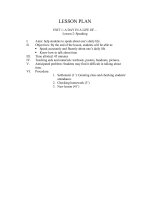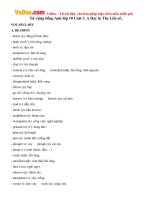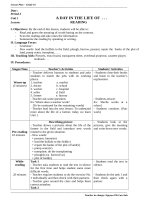english 10,UNIT 1: A DAY IN A LIFE OF… Lesson 2: Speaking
Bạn đang xem bản rút gọn của tài liệu. Xem và tải ngay bản đầy đủ của tài liệu tại đây (1 MB, 10 trang )
LESSON PLAN
UNIT 1: A DAY IN A LIFE OF…
Lesson 2: Speaking
I. Aims: help students to speak about one’s daily life.
II. Objectives: By the end of the lesson, students will be able to:
• Speak accurately and fluently about one’s daily life
• Know how to talk about time
III. Time allotted: 45 minutes
IV. Teaching aids and materials: textbook, posters, handouts, pictures.
V. Anticipated problem: Students may find it difficult in talking about
time.
VI. Procedure:
1. Settlement (1’): Greeting class and checking students’
attendance.
2. Checking homework (3’)
3. New lesson (41’)
Time Stage Activities Work
arrangement
4’ Warm-up Guessing game: SUBJECTS AT SCHOOL
- T elicits some subjects at school from Ss by
asking:
+ Can you tell me some subjects that you have
learned at school?
Expected answer: physics, mathematics,
literature, history, geography, physical
education, English, civic education,
chemistry, Information technology, biology.
- T gives instruction:
I have a box. There are many subjects in this
box. One of you will come here and take a
piece of paper. Your duty is trying to describe
the subject to your friends to help them guess
what it is. But, don’t use the exact word on the
paper.
- T checks instruction:
+ What is this? (Ss: a box)
+ What are there in this box? (Ss: subjects)
+ What will you do in this game? (Ss:
describe and guess these subjects)
- T gives model:
T: What is the subject in which we learn
about the events happening in the past?
Ss’ expected answer: history.
T - whole
class
Subjects at
school
Physics
English
5’ Pre-
speaking
How to talk about time:
- T presents the way to talk about time.
+ We use “PAST” to say times after the hour
from 1
st
min to 30
th
min.
Ex: 8:20 => twenty past eight
+ We use “TO” to say times before the hour
from 31
st
min to 59
th
min.
Ex: 8:35 => twenty-five to nine
+ We use “O’CLOCK” to say full hour.
Ex: 8:00 => eight o’clock
+ Note:
15 minutes = a quarter
30 minutes = half
Ex: 8:45 => a quarter to nine
8: 30 => half past eight
- T shows the posters and asks Ss to answer
the question for each poster.
+ Excuse me, What time is it?
+ Sorry, could you tell me the time, please?
Poster 1 poster 2
Poster 3 poster 4
Poster 5 poster 6
T – whole
class
Expected answers:
1. a quarter past twelve
2. a quarter to seven
3. half past four
4. three o’clock
5. twenty-five to eight
6. ten past six
4’
While-
speaking
Task 1: Fill in the timetable
- T gives Ss handouts.
Handout1:
Monday Tuesday Wednesday Thursday Friday Saturday
7:15 Civic
education
Physical
education
English
8:05 Literature Geography Information
technology
8:55 Maths Literature Maths
9:55 Chemistry Physics
10:40 Class
meeting
Handout 2:
Monday Tuesday Wednesday Thursday Friday Saturday
7:15 Physics Maths Literature
8:05 Information
technology
Literature English
8:55 Biology History English
9:55 Maths Physics Physical
education
Maths
10:40 Chemistry
- T gives instruction:
First, keep your papers for yourselves. Next,
each of you finds a partner. If you are A, find
a B and if you are B, find an A. Quan’s a
student at grade 10. Each of you has a part of
Quan’s weekly timetable. It means that there
are some lessons on your paper but not on
your partner’s paper and vice versa, there are
some lessons on your partner’s paper but not
on yours. Now, work in pairs and ask and
complete the timetable. You will have 5 mins
to do this task.
- T checks instruction:
1. T: How many minutes do you have to do
this task?
Ss: 5 minutes.
2. T: What are you going to doing in this task?
Ss: asking and complete the timetable.
- T gives model by making a short
conversation with a student:
T – whole
class
T – Student
5’
3’
3’
5’
3’
T: What lesson does Quan have at a
quarter past seven on Monday?
S: He has Civic education lesson.
- Ss work in pair
( T goes around to control and offer help if
necessary)
- T calls some pairs to check.
- T gives feedback and corrects Ss’mistakes if
any.
Task 2: Do survey
- T draws a 2-column table on the blackboard.
Time Activity
- T gives instruction:
Copy the table in your notebooks. Work in
pairs and ask your partner about his/her daily
activities. Fill the information you get in the
table. You have 5 minutes to ask and answer.
- T helps by giving some questions such as:
+ What time do you get up?
+ What do you often do at 7:30 a.m?
…
- T checks instruction:
+ How many minutes do you have to do this
task?
Ss: 5 minutes
+ What do you ask for?
Ss: daily activities.
- Ss work in pairs.
- T goes around to control class and offer help
if necessary.
- T calls on some ss to report their partner’s
answers.
- T gives feedback corrects Ss’ mistakes if
any.
Pair work
T – whole
class
Pair work
T – whole
class
4’
4’
1’
Post-
speaking
Write it up
- T gives instruction:
Each of you writes a short paragraph about 3
– 5 sentences to talk about the activities you
often do in the afternoon.
- T checks instruction:
+ How many sentences are you going to
write? (Ss: 3-5 sentences)
+ Do you write about the activites in the
morning? (Ss: No, in the afternoon)
- T goes around, offers help if necessary and
corrects mistake if any.
- T calls on a student to write his/her work on
the blackboard and checks.
- T gives homework:
+ Learn the way to talk about time by heart.
+ Write a paragraph to talk about the activities
you often do in a whole day.
+ Prepare next lesson: listening.
T – whole
class
Individual
work
T – whole
class
APPENDIXES
A
Monday Tuesday Wednesday Thursday Friday Saturday
7:15 Civic
education
Physical
education
English
8:05 Literature Geography Information
technology
8:55 Maths Literature Maths
9:55 Chemistry Physics
10:40 Class
meeting
B
Monday Tuesday Wednesday Thursday Friday Saturday
7:15 Physics Maths Literature
8:05 Information
technology
Literature English
8:55 Biology History English
9:55 Maths Physics Physical
education
Maths
10:40 Chemistry









